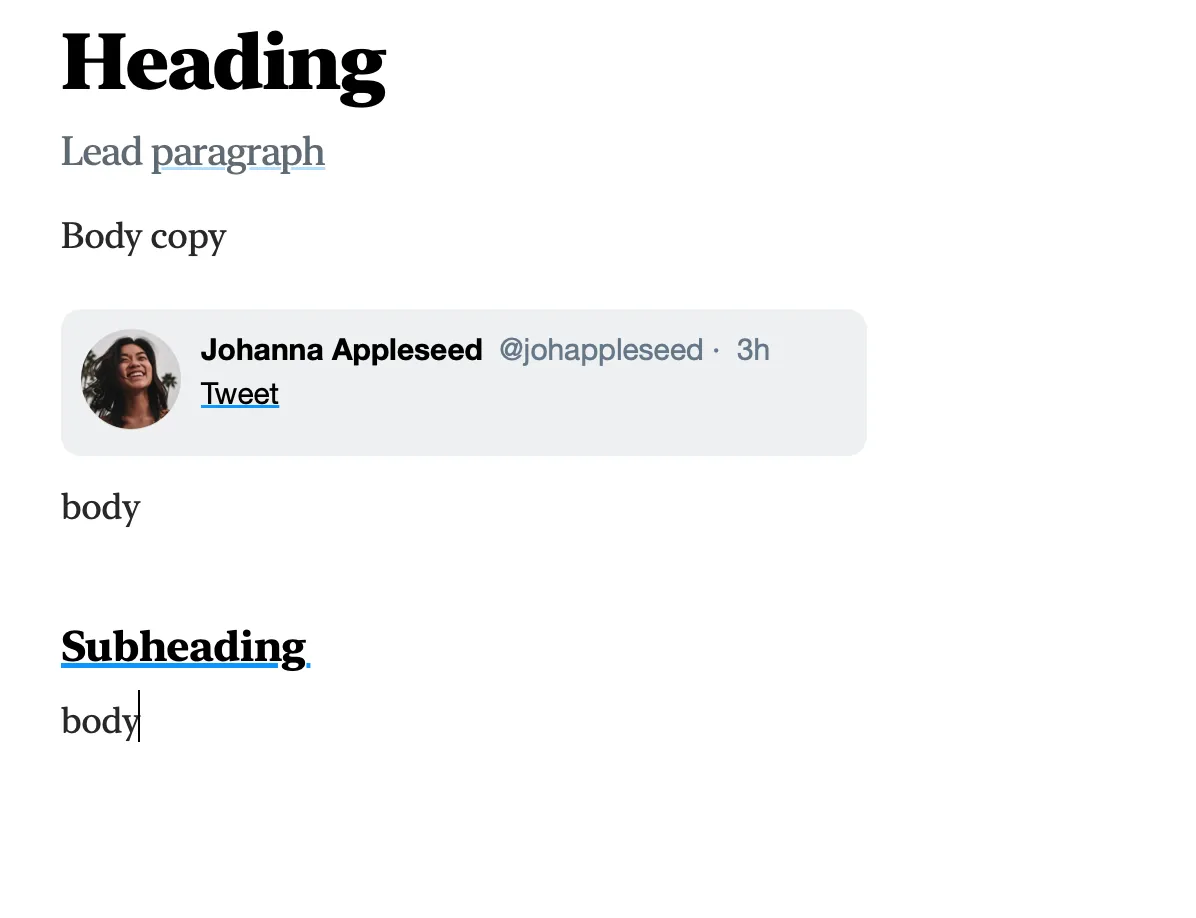TweetTextBlock 子类转换为一个 NSTableViewTextBlock,这也解释了边框。
实现
这是一个完整的Xcode项目。使用顶部菜单中的格式选项来触发markTweet函数。
以下是我如何向段落添加属性:
@IBAction func markTweet(_ sender : Any?){
print("now we are marking")
let location = textView.selectedRange().location
guard let nsRange = textView.string.extractRange(by: .byParagraphs, at: location) else { print("Not in a paragraph"); return }
let substring = (textView.string as NSString).substring(with: nsRange)
let tweetParagraph = NSMutableParagraphStyle()
tweetParagraph.textBlocks = [TweetTextBlock()]
let twitterAttributes : [AttKey : Any] = [
AttKey.paragraphStyle : tweetParagraph,
AttKey.font : NSFont(name: "HelveticaNeue", size: 15)
]
textView.textStorage?.addAttributes(twitterAttributes, range: nsRange)
}
这是我的NSTextBlock子类
import Cocoa
class TweetTextBlock: NSTextBlock {
override init() {
super.init()
setWidth(33.0, type: .absoluteValueType, for: .padding)
setWidth(70.0, type: .absoluteValueType, for: .padding, edge: .minX)
setValue(100, type: .absoluteValueType, for: .minimumHeight)
setValue(300, type: .absoluteValueType, for: .width)
setValue(590, type: .absoluteValueType, for: .maximumWidth)
backgroundColor = NSColor(white: 0.97, alpha: 1.0)
}
override func drawBackground(withFrame frameRect: NSRect, in controlView: NSView,
characterRange charRange: NSRange, layoutManager: NSLayoutManager) {
let frame = frameRect
let fo = frameRect.origin
super.drawBackground(withFrame: frame, in: controlView, characterRange:
charRange, layoutManager: layoutManager)
// draw string
let context = NSGraphicsContext.current
context?.shouldAntialias = true
let drawPoint: NSPoint = CGPoint(x: fo.x + 70, y: fo.y + 10)
let nameAttributes = [AttKey.font: NSFont(name: "HelveticaNeue-Bold", size: 15), .foregroundColor: NSColor.black]
var handleAttributes = [AttKey.font: NSFont(name: "HelveticaNeue", size: 15), .foregroundColor: NSColor(red: 0.3936756253, green: 0.4656872749, blue: 0.5323709249, alpha: 1)]
let nameAStr = NSMutableAttributedString(string: "Johanna Appleseed", attributes: nameAttributes)
let handleAStr = NSAttributedString(string: " @johappleseed · 3h", attributes: handleAttributes)
nameAStr.append(handleAStr)
nameAStr.draw(at: drawPoint)
let im = NSImage(named: "profile-twitter")!
im.draw(in: NSRect(x: fo.x + 10, y: fo.y + 10, width: 50, height: 50))
}
required init?(coder: NSCoder) {
super.init(coder: coder)
}
}
我尝试过的方法
我的想法是,这可能是因为TextKit不知道如何存档自定义块中的属性。但我尝试重写init:fromCoder和encode。它们没有被调用。不是在复制、粘贴、归档、解档时。所以我认为那不是问题所在。这让我想到,所有这些自定义绘图逻辑都不能保存在属性字符串中,而且这一切都发生在布局管理器中。这很有道理。但是,我该如何持久化这个块呢?
更新:我尝试读取属性。它具有一个段落样式,该段落样式在textBlocks数组属性中有一个项目。但是该文本块是一个NSTextBlock而不是我的子类(我尝试了if block is TweetTextBlock,它返回false)。
更新2:我尝试覆盖像classForArchiver这样的属性,然后使用例如print("twb: Class for archiver", block.classForArchiver)读取它们。有趣的是,文本块已经变成了NSTextTableBlock!我现在深入研究这个问题,正在寻找一种将className存储在文本块中的方法。到目前为止,我唯一能想到的是tooltip属性,但那对用户可见,我可能想用它来做其他事情。
更新3:tooltip也没有被保留。这很奇怪。我能想到的下一个大型黑客攻击是将文本颜色设置为HSB(n,0,0),其中n是NSTextBlock子类的标识符。希望我不必去那里。
更新4:最有可能的原因是将字符串进行归档和复制/粘贴转换为RTF格式。这是来自我的剪贴板的public.rtf。
{\rtf1\ansi\ansicpg1252\cocoartf2509
\cocoatextscaling0\cocoaplatform0{\fonttbl\f0\fnil\fcharset0 HelveticaNeue;}
{\colortbl;\red255\green255\blue255;\red245\green245\blue245;}
{\*\expandedcolortbl;;\csgray\c97000;}
\pard\intbl\itap1\tx560\tx1120\tx1680\tx2240\tx2800\tx3360\tx3920\tx4480\tx5040\tx5600\tx6160\tx6720\pardirnatural\partightenfactor0
\f0\fs30 \cf0 THIS text is in a TweetTextBlock}

